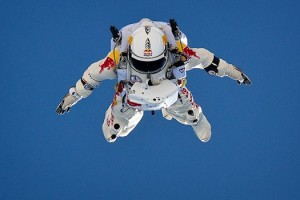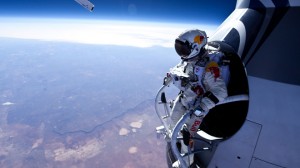The three month’s analysis of data regarding the historic jump of Austrian adventurer Felix Baumgartner has brought interesting results. During his supersonic fall from the edge of space, Baumgartner was hurtling even faster than previously calculated. The final data were made public as a part of a comprehensive report issued on February 5, 2013.
What are the revised figures then? Even though jumping from an altitude slightly lower than originally estimated (38,969 m instead of 39,045 m), Felix Baumgartner, after entering freefall and breaking the sound barrier, reached the speed of almost 1,357 km/h (almost 15 km/h more than previously calculated), which is 121 km/h faster than the speed of sound.
The Austrian daredevil later described the feelings he experienced during the acceleration: “It feels like you are floating into space, and then you pick up speed very fast – but you don’t feel the air because the air density is so low. For almost 35 seconds I couldn’t sense the air around me because basically there was none,” he said.
The mission proved that humans can be safely accelerated through the sound barrier, if outfitted with proper equipment and well trained. This is a breakthrough fact for the nascent space tourism industry, as it says that there is a way to save passengers of a crashing space plane. “Together we proved that a human in freefall can break the speed of sound returning from near space, going through a transonic phase and landing safely on the ground,” said Dr. Jonathan Clark, Red Bull Stratos Medical Director.

Felix Baumgartner plummets toward Earth in a spacesuit during a test skydive (Credits: Jay Nemeth/Red Bull Content Pool).
Awaited data about Baumgartner’s physiological parameters pre-flight, during the flight, and post flight, were released as a part of this report. Altogether, the comprehensive physiological monitoring provided more than 100 million data points, including the first ever physiological information about a human in a supersonic freefall.
Baumgartner, whose heartbeat during the pre-launch oxygen pre-breathe period was in the range between 40 and 100 beats per minute (bpm), achieved his maximum heart frequency when exiting the capsule. The thrill of leaping towards the Earth increased his heartbeat to 185 bpm; it later slowed down to 155 -175 bpm during the freefall phase. These values are still lower than the highest heartbeat frequencies of professional athletes. When hitting the speed of sound, the BASE jumper’s heartbeat measurements showed 169 bpm. His breath frequency during the critical freefall stage was 30 – 43 breaths per minute
The documentation was finalized and privately peer reviewed during the Red Bull Stratos Scientific Summit at the California Science Center on January 23, 2013. Present during the evaluation were experts from NASA, U.S. Airforce, and private aerospace companies such as Virgin Galactic, Northrop Grumman, SpaceX, XCor, and Sierra Nevada Corporation.
During his breakthrough jump on October 14, 2012, Baumgartner experienced 25.2 seconds of absolute weightlessness. When hitting the area of denser air, he started spinning in a flat position but, fortunately being a skilled skydiver, he was able to stabilize himself after 13 seconds. The G loads during this spinning phase were always within safety margins. If the G values had reached 3.5 and lasted for more than 6 seconds, his stabilization parachute would have been automatically deployed.
The data analysis will continue and the results are expected to be presented in space-related conferences and journals. Some of the innovative technologies developed during the Red Bull Stratos program will probably be transferred into other areas – the pressurized suit and parachute innovations among them, as well as some of the medical protocols, including a protocol for treating ebullism
With his jump, Felix Baumgartner broke a record previously held by Joe Kittinger who in 1960 jumped from the altitude of 31,333 meters.
You can watch a short recap of Baumgartner’s jump is in the following video.
[youtube http://www.youtube.com/watch?v=OcU5Duvp7JI]





























![A trajectory analysis that used a computational fluid dynamics approach to determine the likely position and velocity histories of the foam (Credits: NASA Ref [1] p61).](http://www.spacesafetymagazine.com/wp-content/uploads/2014/05/fluid-dynamics-trajectory-analysis-50x50.jpg)



Leave a Reply